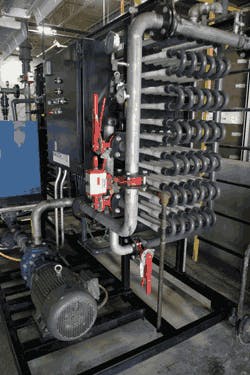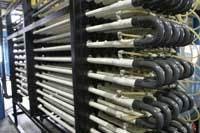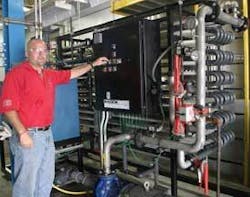Whirlpool Uses Membranes to Turn Oily Wastewater into Revenue Stream
by Tim Jordan
The production process at the Whirlpool facility in Clyde, OH, uses membranes manufactured by Koch Membrane Systems to greatly reduce the waste it generates.
• FEG PLUS Membranes from Koch Membrane Systems Aids Oil/Water Separation at World’s Largest Washing Machine Factory.
Even the largest washing machine manufacturing plant in the world has its own cleaning challenges. Every day, thousands of washing machines - over half the units sold in North America - come off the line at the Whirlpool Corp. facility in Clyde, OH, where the production process generates large amounts of oily wastewater.
A Slick Problem
Machining and metal finishing processes at the Clyde plant impart hundreds of different synthetic and petroleum-based lubricants into the wastewater. The oily waste is segregated from the wastewater stream and separated into a concentrated oily phase and an aqueous phase. Concentrated oil is sold to oil recycling companies, and the aqueous phase is further treated by the plant’s metal hydroxide precipitation process before it’s discharged to a sanitary sewer. The plant as a whole produces a daily flow of over 450,000 gpd of wastewater.
“A decade ago, we used to separate and concentrate the oily waste with a crude process of applying acid to break up the oil molecules from the water,” said senior environmental engineer Mark T. DelGarbino, who has 15 years of experience at Whirlpool’s Clyde Division. “This process, however, was costly and labor-intensive, and it didn’t adequately concentrate the oily waste. We were achieving concentrations averaging only 70-75%, and it’s obviously not good economically or environmentally to be shipping off 30% water. We realized we needed a process that could handle the increasingly large volume and diversity of lubricants from our manufacturing processes.”
DelGarbino turned to Koch Membrane Systems Inc. (KMS) for a solution.
“KMS has long been established as a supplier of membrane separation equipment, and we have extensive experience with its RO process that’s used in our electrocoat paint operation which makes deionized water,” he said. “With my significant involvement with the paint department and its processes and suppliers, I viewed KMS as a good resource when I began looking for an oil-water separation supplier.”
After a competitive testing and bidding process, Whirlpool chose the KMS KONSOLIDATORTM 78, a completely self-contained ultrafiltration (UF) system, using FEGTM PLUS tubular membranes. The membranes have been used in wastewater treatment for over 30 years in many industries worldwide.
The robust system is capable of concentrating wastewater to an extremely high level, dramatically reducing the volume of waste. It’s designed with 78 tubular UF membranes with large flow channels to accommodate streams with significantly high concentrations of solids. To maintain high permeate rates and minimize use of cleaning chemicals, the system features a mechanical cleaning process that utilizes spongeballs that are introduced into the cleaning solution and forced under pressure into the tubular membranes. As the spongeballs pass through the tubes, they wipe the membrane surface clean of accumulated debris.
Overall Reductions
“The system has performed very well,” DelGarbino said. “I attribute our success to the quality of the system and to the diligence of our technicians. Of the 78 tubes, we’ve only had to replace four of them since we commissioned the system eight years ago.”
The Clyde plant achieved its goal of reducing the volume and cost of concentrated oil that’s trucked off-site. Waste oil concentration is now at least 90%, which translates into a 60-67% reduction in the water volume in each gallon of concentrated material compared to before the system was installed. In 2005, the UF system processed a total of 3.5 million gallons of oily wastewater, resulting in a total of 103,000 gallons of used oil. While the oil is shipped offsite, the permeate from the system is sent into the wastewater treatment process before being discharged to the sewer.
Before the membrane system was installed, the old acid split process required weekly chemical treatment of batches. Now, acid is only required occasionally when there’s a batch abnormality. Overall reduction in chemical consumption has resulted in significant cost savings for Whirlpool and resulted in a safer working environment for its employees.
Labor costs also have been reduced significantly. The holding tank for the oil-water separation process now fills automatically from the main wastewater collection tank, and the UF system runs continuously with little need for intervention. Although the entire wastewater treatment operation at the Clyde plant is monitored 24/7, the whole process requires little maintenance.
“With the membrane system, our employees no longer need to continually perform jar testing,” said DelGarbino. “They simply monitor the system, and about once a month, we perform a cleaning cycle with the spongeball system and KMS’ KOCHKLEEN membrane cleaning solution to maintain high flux and extend the life of the membranes.”
Conclusion
From a financial standpoint, the return on investment for the KONSOLIDATOR system has exceeded expectations. “Originally, we expected the membrane system to pay for itself by lowering disposal costs with more concentrated sludge and reducing chemical consumption and labor costs,” DelGarbino said.
“We didn’t expect, in addition to these cost-reductions, we would also create a new and growing revenue stream for Whirlpool. Now that the oil is more concentrated, it’s more valuable to companies that collect it for oil recycling. More concentrated material lowers transportation costs and the amount of processing required, so recycling companies pay us more. During each of the past two years, we sold our used oil for more than $20,000. And we’re on track to make even more this year.”
With the increasing prices for oil products worldwide, this revenue stream is likely to increase in the future.
About the Author: Tim Jordan is Midwest sales manager for industrial water & wastewater applications at Koch Membrane Systems, of Wilmington, MA. Contact: 888-677-5624, [email protected] or www.kochmembrane.com



